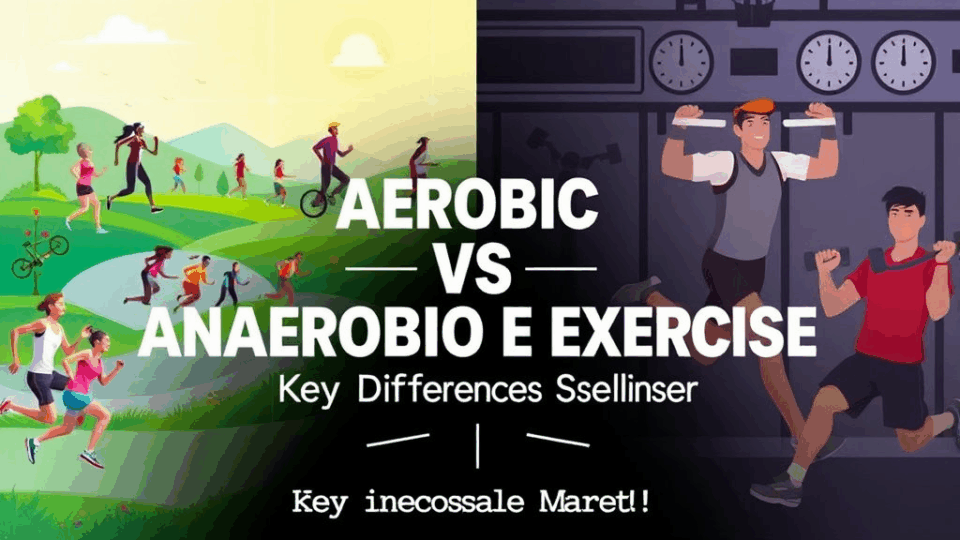
Aerobic vs Anaerobic Exercise: Key Differences Explained
Energy Systems Explained

When it comes to understanding the difference between aerobic and anaerobic exercise, it’s helpful to start with how your body creates and uses energy. Our bodies rely on three main energy systems to fuel movement: the phosphagen system, the glycolytic system, and the oxidative system. Each system kicks in depending on the intensity and duration of the activity.
Aerobic exercise, like jogging, swimming, or cycling, primarily uses the oxidative system. This system relies on oxygen to convert carbohydrates and fats into energy. It’s efficient and sustainable, making it ideal for longer, steady-state activities. That’s why you can jog for 30 minutes without collapsing—your body is steadily producing energy using oxygen.
Anaerobic exercise, such as sprinting or heavy weightlifting, relies on the phosphagen and glycolytic systems. These systems don’t require oxygen and provide quick bursts of energy. The phosphagen system is used for very short, explosive movements (like a 100-meter sprint), while the glycolytic system supports slightly longer high-intensity efforts (like a 400-meter run or a set of squats). However, these systems fatigue quickly, which is why anaerobic exercises are usually done in short intervals.
Understanding these energy systems can help you tailor your workouts to meet your goals. Want to build endurance? Focus on aerobic activities. Looking to increase power and strength? Anaerobic training is your friend. By knowing how your body fuels itself, you can train smarter and more effectively.
Duration and Intensity

When it comes to choosing between aerobic and anaerobic exercise, understanding the differences in duration and intensity can help you tailor your workouts to better meet your fitness goals.
Aerobic exercise, like jogging, swimming, or cycling, is typically performed at a moderate intensity over a longer period of time—usually 30 minutes or more. These activities rely on oxygen to generate energy, making them ideal for improving cardiovascular health, endurance, and fat burning. If you’re looking to build stamina or maintain a healthy heart, aerobic workouts are your go-to.
On the other hand, anaerobic exercise, such as sprinting, heavy weightlifting, or high-intensity interval training (HIIT), involves short bursts of high-intensity effort. These workouts usually last from a few seconds to a couple of minutes and rely on energy sources stored in the muscles, not oxygen. Anaerobic exercises are fantastic for building muscle strength, power, and speed.
Incorporating both types of exercise into your routine can provide a balanced approach to fitness. Aerobic workouts help with long-term endurance and heart health, while anaerobic sessions boost muscle tone and metabolic rate. Knowing when and how to use each can truly elevate your fitness journey.
Key Health Benefits

When it comes to improving your overall health, both aerobic and anaerobic exercises offer unique and powerful benefits. Understanding these can help you choose the right mix for your fitness goals and lifestyle.
Aerobic exercise, such as walking, swimming, or cycling, primarily improves cardiovascular health. It strengthens your heart, increases lung capacity, and boosts circulation. Over time, this can reduce your risk of heart disease, lower blood pressure, and help manage cholesterol levels. Aerobic workouts also enhance endurance and are excellent for weight management by burning calories efficiently.
On the other hand, anaerobic exercise—like weightlifting, sprinting, or high-intensity interval training (HIIT)—focuses on building muscle strength and power. These workouts help increase lean muscle mass, which in turn boosts your metabolism and supports long-term fat loss. Anaerobic training also improves bone density and supports joint health, making it especially beneficial as we age.
Combining both types of exercise can lead to a well-rounded fitness routine that supports heart health, muscular strength, and overall well-being. Whether you’re aiming to lose weight, gain strength, or simply feel more energized, understanding these key health benefits can guide you toward a healthier, more active life.
Combining Both for Best Results

When it comes to achieving your fitness goals, combining aerobic and anaerobic exercises can be a game-changer. Each type of exercise offers unique benefits—while aerobic workouts like jogging, swimming, or cycling improve cardiovascular health and endurance, anaerobic exercises such as weightlifting or sprinting help build strength, power, and muscle mass.
By blending both into your weekly routine, you can enjoy the best of both worlds. For example, doing strength training two to three times a week alongside regular cardio sessions can boost your metabolism, enhance fat loss, and improve overall body composition. This balanced approach also reduces the risk of injury, as stronger muscles support better joint stability and posture.
Moreover, alternating between aerobic and anaerobic workouts can keep your routine fresh and engaging, making it easier to stay consistent. Whether you’re training for a race, looking to lose weight, or simply aiming to feel more energetic, combining both types of exercise can help you reach your goals more efficiently and sustainably.
Remember, it’s always a good idea to listen to your body and consult with a fitness professional when starting a new workout plan. With the right mix of aerobic and anaerobic activities, you’ll be well on your way to a healthier, stronger you!


답글 남기기